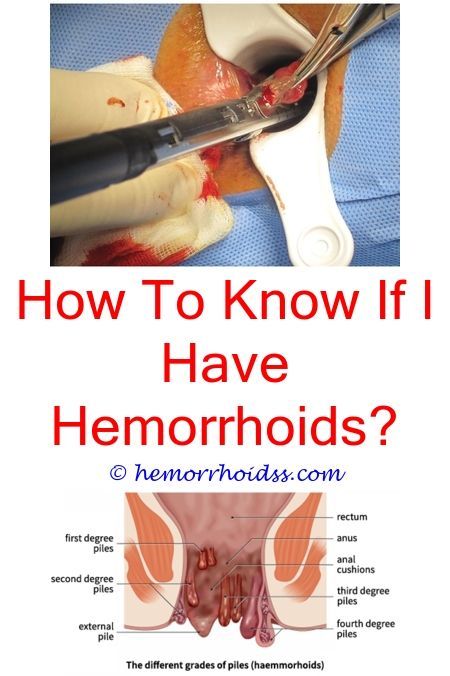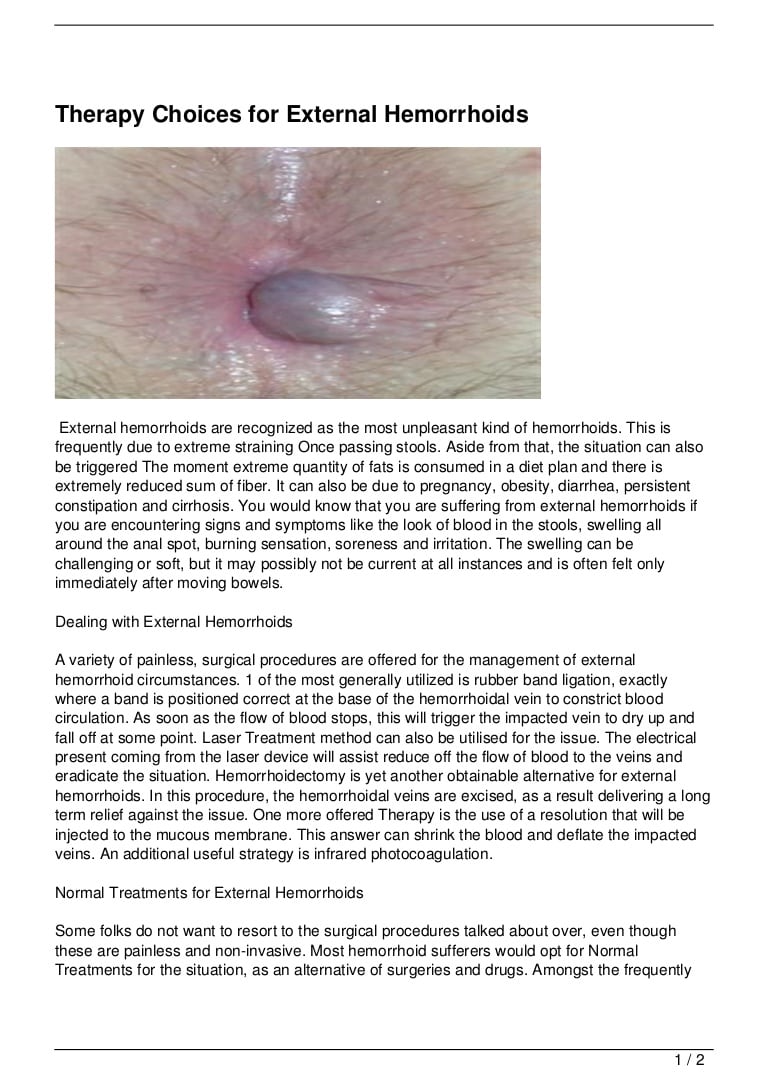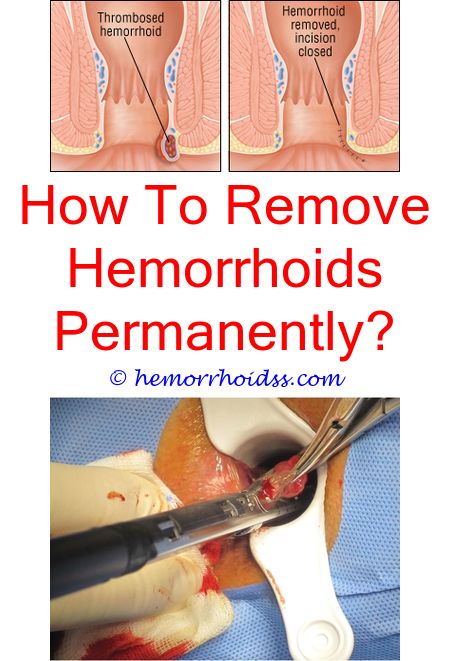What Are The Signs And Symptoms Of An External Or Thrombosed Hemorrhoid
Thrombosed external hemorrhoids are a painful condition. These occurs when a blood clot develops in a hemorrhoidal blood vessel causing swelling and inflammation.
- When a blood clot occurs in a hemorrhoid, the hemorrhoid will become even more swollen. This swelling leads to increased pain.
- The pain is usually worse with bowel movements and may increase with sitting.
A thrombosed external hemorrhoid may resolve on its own however, this condition often needs medical care. Bleeding with a bowel movement is never normal and should prompt a visit to a health-care professional. While hemorrhoids are the most common cause of bleeding with a bowel movement, there may be other reasons for bleeding including inflammatory bowel disease, infection, and tumors.
Hemorrhoids are not arteries or veins, but instead are normal blood vessels called sinusoids that are located in the walls that surround the rectum and anus. When the venous pressure within these blood vessels increases, the hemorrhoids swell and dilate, because it is more difficult for blood to empty from them. This leads to the most common symptoms of bleeding and swelling.
Common situations that increase pressure within the hemorrhoidal blood vessels and lead to abnormalities include the following.
- Straining to have a bowel movement. This may be due to constipation or diarrhea.
- Prolonged sitting, including on the toilet
- Lack of exercise
How To Heal Hemorrhoids: Over
Products used to treat hemorrhoids are available as
- ointments,
- foams, and
- pads.
When used around the anus, ointments, creams, and gels should be applied as a thin covering. When applied to the anal canal, these products should be inserted with a finger or a “pile pipe.” Pile pipes are most efficient when they have holes on the sides as well as at the end. Pile pipes should be lubricated with ointment prior to insertion. Suppositories or foams do not have advantages over ointments, creams, and gels.
What Are The Symptoms Of External Hemorrhoids
Unlike internal hemorrhoids, external hemorrhoids are located in an area with nerve endings, which can make them easier to identify but also significantly more uncomfortable. Patients with external hemorrhoids usually report experiencing acute pain or discomfort, especially during bowel movements. However, these symptoms may flare up only every so often, making it difficult to tell whether the discomfort is actually hemorrhoid-related.
Many of those with external hemorrhoids also have symptoms of internal hemorrhoids. While a licensed physician is the only one who can give you a dependable diagnosis, these are some symptoms that typically indicate an external hemorrhoid problem:
- Mild but consistent itching around the rectal area
- Pain around the anal area, ranging from mild to severe
- Swelling around the anus
You may also notice your external hemorrhoids particularly swell when bearing down during a bowel movement. Be sure to limit your time on the toilet to two minutes as additional straining can worsen your external hemorrhoids. If you find that you frequently have to strain to pass bowel movements, try to increase your fiber and water intake. Eating foods with fiber is the most beneficial way to get this carbohydrate, but you can also take fiber supplements. The recommended intake is 20 to 30 grams per day.
Recommended Reading: How To Get Rid Of Inside Hemorrhoids
What Happens If A Hemorrhoid Bursts
If a hemorrhoid bursts, you should experience relief from pain and discomfort. When this happens, you can expect some bleeding to occur. You should keep the area clean to lower the risk of infection.
If you need treatment for hemorrhoids, please contact Gotham Gastroenterology to schedule an appointment.
You Might Also Enjoy…
Hemorrhoid Medication: When Why And Which Ones To Use

A number of OTC creams, ointments, and pads that contain hydrocortisone or witch hazel are available to help relieve pain, swelling, and itching caused by hemorrhoids. According to the National Institute of Diabetes and Digestive and Kidney Diseases, doctors recommend using over-the-counter products for a week. If symptoms persist beyond a week, follow up with your doctor.
Creams and suppositories containing hydrocortisone can cause the skin to weaken and thin, so they should not be used for more than a week. If any of these creams cause a rash or dry skin around the area, contact your healthcare provider.
A fiber supplement, such as Metamucil , or a stool softener, such as Citrucel , can help prevent constipation.
Avoid laxatives, which can lead to diarrhea and worsen hemorrhoid symptoms.
You May Like: How Do I Stop My Hemorrhoids From Bleeding
How Do I Know If I Have External Hemorrhoids
Depending on the severity of your external hemorrhoids, symptoms are more obvious than that of internal hemorrhoids.
If you have hemorrhoid itching and burning, or pain around the anus, lumps near the anus, or blood in your stool, these are indications that you may have external hemorrhoids.
Another sign of external hemorrhoids is a feeling of pressure on the bowel. If you suspect you have external hemorrhoids, a hemorrhoid doctor can perform a rectal exam to verify your diagnosis.
If you have internal hemorrhoids, check out our internal hemorrhoids guide for more information.
What Is Stapled Hemrroidectomy
The following are pictures of the stapled hemorrhoidectomy procedure.
- Picture of Hollow Tube Inserted into the Anal Canal and Pushing up the Hemorrhoids
- Picture of Internal Hemorrhoids in Anal Canal
- Picture of Suturing the Anal Canal through the Hollow Tube
- Picture of Bringing Expanded Hemorrhoidal Supporting Tissue into the Hollow Tube by pulling On Suture
- Picture of Hemorrhoids Pulled Back Above Anal Canal after Stapling and Removal of Hemorrhoidal Supporting Tissue
Don’t Miss: What Is Good To Use For Hemorrhoids
First Signs Of Female Hemorrhoids On Photos
In each case, the first signs of hemorrhoids in women are individual. Often they are not obvious and dont cause major discomfort. The initial stage of piles with timely treatment is completely curable. Signs of female piles are expressed with a burning sensation, tingling, itching of the anus.
Often there are inflammations and puffiness. Signs of piles in women are often expressed in the intestines, and get more pronounced closer to the anus. Traces of blood should be reason to consult a doctor, in case they are noticed on underwear or toilet paper. Female hemorrhoids 1 stage may be manifested only by the mucus discharge from the anus.
What Can You Put On Hemorrhoids To Shrink Them
You can use topical medications for hemorrhoids, although these products mainly provide relief from pain and other symptoms rather than shrinking hemorrhoids. A wide range of these products are available, including ointments, pads, and creams. Oral pain relievers might also offer temporary relief. Soaking in a sitz bath or warm water can help ease the pain as well.
Also Check: What The Best Over The Counter Medicine For Hemorrhoids
Is Hemorrhoid Removal Surgery Painful
Minor or minimally invasive hemorrhoid removal surgery is usually not painful. These procedures typically involve the use of a local anesthetic, which numbs the affected area. More severe or persistent hemorrhoids might require removal that is more invasive, such as hemorrhoidectomy, although these are done less often.
What Do Hemorrhoids Look Like In Pregnancy
Depending on what type of hemorrhoid you have during pregnancy, hemorrhoids will look like a skin-colored cluster of bumps, and the size of which depends on the severity.
These are external hemorrhoids, and when they become thrombosed, they can appear blue or purple due to the blood clot formation trapped inside of them.
Internal hemorrhoids are not visible because they are located in the lowest part of the rectum.
During pregnancy, you may experience rectal bleeding, and this is the only indication of the presence of irritated internal hemorrhoids.
Also Check: What To Do To Heal Hemorrhoids
Why Do External Hemorrhoids Itch
External hemorrhoids often cause moderate to severe itching around the anus. The itching comes from the inflammation of your anal area.
As inflammation increases due to external hemorrhoids, the intensity of your itching will increase as well.
For a list of products that can help, take a look at our guides below.
Dont Miss: What To Do When Your Hemorrhoids Are Swollen
Types Of External Hemorrhoids

Hemorrhoids are classified as either internal or external. While most hemorrhoids fall under one of these two categories, prolapsed or thrombosed hemorrhoids can have qualities of both.
A prolapsed hemorrhoid is an internal hemorrhoid that can protrude out of the anus, appearing to be an external hemorrhoid.
A thrombosed hemorrhoid is an external hemorrhoid that has prolapsed and formed a blood clot. This is the most painful type of hemorrhoid.
Hemorrhoids also fall into four different stages based on size, severity of symptoms, and required treatments.
To discover the most common cause of hemorrhoids be sure to take a look at this post.
Don’t Miss: How To Use Sitz Bath For Hemorrhoids
What Causes External Hemorrhoids
The most common cause of external hemorrhoids is repeated straining while having a bowel movement. Hemorrhoids develop when the veins of the rectum or anus become dilated or enlarged and can be either internal or external. External hemorrhoids are usually found beneath the skin that surrounds the anus.
There is a range of symptoms that can affect a person with hemorrhoids. Symptoms tend to vary depending on the severity of your hemorrhoids. Some of the symptoms that you may have include the following:
- itching around the anus or rectal area
- pain around the anus
- blood in the stool
You may notice bleeding when using the bathroom. This includes seeing blood on toilet paper or in the toilet. Lumps around the anus may feel as if they are swollen.
These symptoms may also occur because of other conditions. But if you experience these symptoms, you should schedule an exam with your doctor.
What Should I Eat With Hemorrhoids
Eating whole grains and other foods that are high in fiber can help ease symptoms of hemorrhoids, such as discomfort and swelling. These foods can also help prevent hemorrhoids from forming by making the stool bulky and softening it. This helps you avoid straining, which can lead to hemorrhoids. When you increase your fiber intake, you should do so gradually to lower your risk of having gas.
Recommended Reading: How To Control Bleeding Hemorrhoids
How Are External Hemorrhoids Diagnosed
Because many of the symptoms of external hemorrhoids can also be caused by other conditions, it is necessary to have an in-depth exam. Your doctor may use a series of tests to confirm the presence of external hemorrhoids near the anus. These tests may include:
- proctoscopy
- anoscopy
Your doctor may begin with a physical exam. In cases of external hemorrhoids, they may be able to see the hemorrhoids.
If your doctor suspects that you have internal hemorrhoids instead of external hemorrhoids, they may use an anoscopy to examine the inside of the anus. Internal hemorrhoids can also be seen with colonoscopy, sigmoidoscopy, or proctoscopy.
I Have Had An External Hemorrhoid For Months Is This Normal
Hemorrhoids can last for a several days or several months. The existence of hemorrhoids varies depending on their severity and the treatment. Some hemorrhoids may require medical treatment or surgery.
Many people suffer from hemorrhoids without ever seeking treatment. Depending on how you treat your hemorrhoids will determine how long they last.
Read Also: How To Treat Rectal Hemorrhoids
When Hemorrhoid Surgery May Be Necessary
Very few people fewer than 10 percent of all adults who see a doctor because of symptomatic hemorrhoids will require a surgical operation.
Surgery to remove hemorrhoids is called a hemorrhoidectomy.
Your doctor may recommend a hemorrhoidectomy if:
- You have large external hemorrhoids
- You have both internal and external hemorrhoids
- An internal hemorrhoid has prolapsed
In a hemorrhoidectomy, the doctor makes a small incision to remove the hemorrhoid and surrounding tissue before closing the wound with stitches.
A hemorrhoidectomy is performed in an operating room and can be done under general anesthesia, in which you are unconscious and unable to feel pain.
It can also be done with a spinal anesthetic block while you are awake , or with a combination of relaxing and sedating drugs given intravenously and a local anesthetic injected around the anus.
Hemorrhoidectomy is associated with postoperative pain, but the procedure is successful for 95 percent of cases.
More recently, another option aimed at avoiding the postoperative pain of a hemorrhoidectomy has become available, called a stapled hemorrhoidopexy. A circular stapling device pulls the hemorrhoidal tissue upward and to its normal position, stapling it in place. The staples eventually fall out over time.
There are many options for the treatment of hemorrhoids. Its best to discuss the benefits and risks of each of these with your doctor in order to come up with the treatment plan that is best for your particular case.
Gradually Increase Your Fiber Intake
Most of us dont get in enough fiber everyday, but adding more high-fiber foods like beans, broccoli, whole grains, and fresh fruit to your diet can help you avoid constipation and stay regular. This in turn reduces the chances that youll find yourself straining and further irritating your hemorrhoids, says Dr. Thomas. Aim for 20 to 30 grams of fiber a day, and consider taking a fiber supplement that contains psyllium or methylcellulose to help you hit your daily goal. If youre typically low on fiber-rich foods, though, take your timesuddenly upping your intake may make you gassy.
Also Check: How To Treat Severe Hemorrhoids At Home
Can Hemorrhoids Be Prevented Or Avoided
Just about everyone has hemorrhoids at some time. But some things may make you more likely to get them. People whose parents had hemorrhoids may be more likely to get them. Pregnant women often get hemorrhoids because of the strain from carrying the baby and from giving birth. Being very overweight or standing or lifting too much can make hemorrhoids worse.
External Hemorrhoid Healing Time

For small external hemorrhoids, healing time can be as little as a few days even without treatment.
Prolapsed hemorrhoids have a longer healing time and may require doctor treatment.
Depending on the course of treatment, healing time can be as little as a week or as long as a few months.
For women who experience hemorrhoids during pregnancy, they will usually last until after you give birth.
Because every patient is different, and there are several different types of hemorrhoids, healing time for external hemorrhoids will vary based on specific case and specific individual.
Also Check: What Cream To Put On Hemorrhoids
Hemorrhoids Treatment: Rubber Band Ligation
The principle of rubber band ligation is to encircle the base of the hemorrhoidal clump with a tight rubber band. The tissue cut off by the rubber band dies, and is replaced by an ulcer that heals with scarring.
A similar procedure was described in 460 BC by the Greek physician Hippocrates:
And hemorrhoids you may treat by transfixing them with a needle and tying them with very thick and woolen thread, for application, and do not foment until they drop off, and always leave one behind and when the patient recovers, let him be put on a course of Hellebore.
Rubber band ligation can be used with first-, second-, and third-degree hemorrhoids, and may be more effective than sclerotherapy. Symptoms frequently recur several years later, but usually can be treated with further ligation.
The most common complication of ligation is pain. However, bleeding one or two weeks after ligation or bacterial infection in the tissues surrounding the hemorrhoids may occur.
Tips And Advice To Reduce Hemorrhoid Pain At Home
The FDA estimates 75% of people will experience hemorrhoids in their life.
So dont let embarrassment about your hemorrhoids keep you from trying to relieve the pain and discomfort. Odds are you know someone else who has had them.
Sit on cushions. Since hemorrhoids are caused by damaged veins, sitting down can create an increase in the throbbing and pain associated with hemorrhoids.
Try to avoid sitting on hard surfaces as much as possible. By sitting on cushions you can alleviate some of the pressure on your rectal area when sitting down. Specially made hemorrhoid cushions are available for hemorrhoid sufferers.
Cold therapy helps to reduce pressure in the veins, alleviating swelling and throbbing. Use hemorrhoid ice packs or cold compress to help to alleviate pain after an injury to your ankle or knee.
Try laying on your stomach with an ice pack placed on the affected region for 20 minutes, repeating as needed.
Hemorrhoid ointments are over-the-counter creams and salves found at just about any grocery store or pharmacy. You might be familiar with the brand Preparation-H. These ointments provide immediate cooling relief and even reduce itching.
The ointments can sometimes encourage hemorrhoids to shrink, which will reduce the severity of the pain associated with the problem.
If you are dealing with irregularity, consider taking advantage of a stool softener or probiotic that can improve digestive health.
You can also relieve hemorrhoid pain by taking steps like:
Recommended Reading: What To Get For Hemorrhoids
What Happens If External Hemorrhoids Are Left Untreated
A few initial symptoms that indicate you may have external hemorrhoids include an itchy, nagging feeling around the anal area, along with swelling and pain. If left untreated, the condition could worsen and turn into a thrombosed hemorrhoid, which is a large and extremely painful bulge containing clotted blood.
When Should I See A Doctor
Any type of anal pain, especially if it involves bleeding or swelling tissue should be properly evaluated by an MD. The pain may not always be hemorrhoids and its extremely important to see a doctor to make sure theres nothing more serious going on. Other conditions that sometimes exhibit similar symptoms as hemorrhoids include colorectal cancer, IBS, constipation and anal fissures.
Read Also: What Can I Do For Hemorrhoids